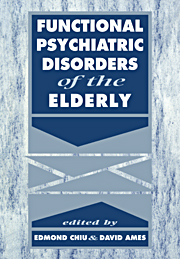Book contents
- Frontmatter
- Contents
- List of contributors
- Preface
- Introduction – A personal note
- Acknowledgement
- Part 1 Classification
- Part 2 General epidemiology
- Part 3 Neuroses
- Part 4 Affective disorders
- Part 5 Psychosexual disorders
- Part 6 Substance use and abuse
- Part 7 Schizophrenia and related psychoses
- Part 8 Psychological, biological and medical issues
- Part 9 Treatment methods
- 25 Geriatric psychopharmacology
- 26 Electroconvulsive therapy in later life
- 27 Family therapy
- 28 Group therapy in the elderly
- 29 Integrated psychotherapy of the elderly
- 30 Management of the treatment team in a multidisciplinary framework
- 31 Occupational therapy
- 32 Nursing management
- 33 Social work and the psychiatry of late life
- 34 Music therapy
- 35 Physiotherapy
- Part 10 Conclusion
- Index
28 - Group therapy in the elderly
from Part 9 - Treatment methods
Published online by Cambridge University Press: 13 November 2009
- Frontmatter
- Contents
- List of contributors
- Preface
- Introduction – A personal note
- Acknowledgement
- Part 1 Classification
- Part 2 General epidemiology
- Part 3 Neuroses
- Part 4 Affective disorders
- Part 5 Psychosexual disorders
- Part 6 Substance use and abuse
- Part 7 Schizophrenia and related psychoses
- Part 8 Psychological, biological and medical issues
- Part 9 Treatment methods
- 25 Geriatric psychopharmacology
- 26 Electroconvulsive therapy in later life
- 27 Family therapy
- 28 Group therapy in the elderly
- 29 Integrated psychotherapy of the elderly
- 30 Management of the treatment team in a multidisciplinary framework
- 31 Occupational therapy
- 32 Nursing management
- 33 Social work and the psychiatry of late life
- 34 Music therapy
- 35 Physiotherapy
- Part 10 Conclusion
- Index
Summary
Introduction
In recent years a great deal has been written about the value of group psychotherapy for older people (Tross & Blum, 1988; Finkel, 1991; Leszcz, 1987, 1991; Lothstein & Zimet, 1988). Few clinics or programs, however, devote extensive resources providing group therapy services to a wide range of older adults. At the Older Adult Program of Northwestern Memorial Hospital, nine diverse group therapy experiences are provided both on-site and in the community at large. Over 80% of this population have diagnoses of functional psychiatric disorders, with depression being the most prevalent. The group therapy modalities include insight-oriented family support, cognitive behavioral, supportive, institutional, activities-oriented, creative, and bereavement groups.
Because there is a shortage of mental health professionals devoted to treating the increasing number of older people with functional disorders, group therapy is a logical and important treatment modality. Besides the obvious economic benefit compared to individual therapy, therapy groups provide nurturance, a sense of sustenance and support that allows older people to enhance their coping mechanisms, to resolve conflicts, and to diminish the disabling symptoms of functional disorders.
Group therapy offers the following special opportunities for older people:
To re-establish well-functioning defenses and coping mechanisms via interactions with other group members and to enhance a sense of usefulness in one another.
To establish a sense of identity as part of a social entity.
To become part of a family unit with a nurturing supportive system that would translate to other environmental situations.
[…]
- Type
- Chapter
- Information
- Functional Psychiatric Disorders of the Elderly , pp. 478 - 498Publisher: Cambridge University PressPrint publication year: 1994



